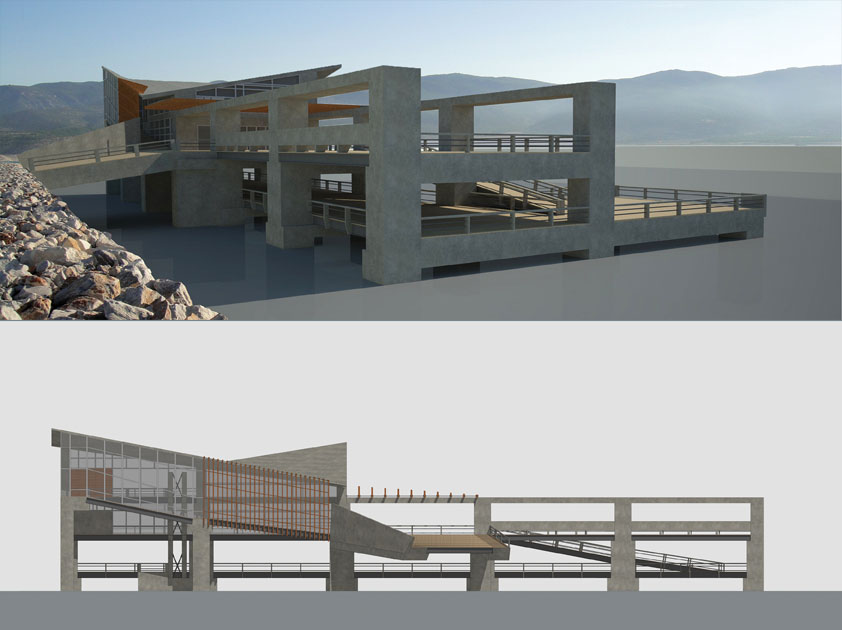

The re-creation of Lake Karla, a process that has been unfolding over the last 10 years and is expected to come to completion in the year 2013, is a significant environmental intervention in the area of SE Thessaly. The new lake shall bring back an ecosystem of aquatic birds and fish, some of which are rare and threatened with extinction. It will thus present motives for activities relevant to the concept of ecotourism, and in its initial phase this scheme is expected to draw some 5,000 visitors annually. These individuals will have the opportunity to follow 7 paths and bike paths of a total length of 85 km, on the perimeter of the lake, and visit the Natural History Museum in Kanalia and the Environmental Information Center in Stefanovikeion.
The suggested Network of Structures for the use of the visitors of Lake Karla offers a third location open to visitors, this time inside the lake itself, that combines the presentation of the history of the lake and of its bird and aquatic species with opportunities to walk around and observe the landscape, take refreshments and light meals, and continue the process of acquaintance and exploration by bringing the visitors close to the lake’s surface. The building becomes a platform that extends the paths of the embankment and affords the prospect of concentrating in one place a variety of activities the visitors may want to follow. Finally, it allows for the visitors to come into contact with the local inhabitants through sightseeing boat tours –the building functioning as a quay-, hosting a fishmongers’ market on specific days and times of the week, and the creation of employment slots that will benefit the residents of the surrounding areas.
Supervisors: Kouzoupi Aspassia, Manolidis Kostas
Reference Number: 296
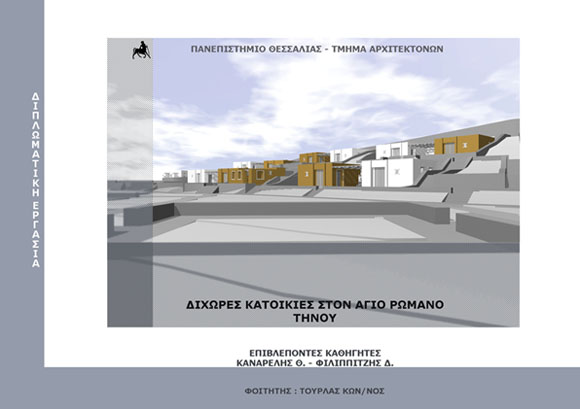

The topic of this dissertation reflects the construction of compartmental holiday residences in Agios Romanos, in the Island of Tinos. The place that they are situated is close to the sea shore. The terrain of the island is best described as rough, in combination with the characteristic scales on the ground. These small scales are structurally used to hold the integrity of the ground during the winter season when the rains tend to dissolve the dirt. More over, the ground on the scales is used for local cultivation, where plants are seeded on the scales.
The residences are characteristic of the island of Tinos, and they can be found across the island in small communities or larger villages. The Cyclades type of architecture is best known for the wise appropriation of the volumetric spaces as well as the building materials. The outcome of this combination creates a unique scope of architectural integration in the landscape which results in a harmonious co-existence between the natural environment and the local buildings.
The compartmental residences, in my dissertation, are situated in a linear way expanded in two levels, well adjusted in the morphology of the inclination of the hill. In an effort to reduce the thermal losses in the residences, I used the specific double linear positioning of the buildings in combination with their north-west orientation. In addition to that, the thermal losses are also minimized, by positioning the buildings partly in the tilted ground of the hill. My original plan was to build the residences in such a way that they take advantage of the morphology of the tilted terrain, in combination with their small cubic shapes that they are dictated by the local architectural mode. It is a complex that takes into account the harmonious co-existence of the human element with the structural aesthetics of the island.
The local public road leads to the entrance of the group of residences, where close to that is situated the building of Reception. Pass the Reception, the dwellers will drive to their residences via the private small routes which also separate the structures in between. At the heart of the complex, one can find the pre-existent building A (cafeteria). The second building that also pre-existed the complex, is the building B which is used as a parking lot.
Regarding the residences, each of the compartmental buildings is designed as a two-volume structure separated by a yard, that creates a building - vacuum - building architectural equation. The building materials that are used are traditionally of local origin. Specifically, the use of stone creates a unique combination with the white color that is predominant in the Cyclades architectural style. The narrow openings in the residences are few in numbers, and the overarching element of each residence is the balcony door in a white margin that stands out in every building. In conclusion, the proper development of the common areas of the complex, i.e. the paths that can be used for a stride, or rest, gives the right feeling of leisure time in these summer residences, close to the sea.
Supervisors: Philippitzis Dimitris, Kanarelis Theoklis
Reference Number: 287
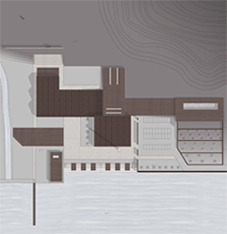

This Diploma Thesis, which is in continuation of my Final Research Topic, focuses on the deserted village of «Palios Platanos» which is faced by me, as a landscape that leads to continuously transformations as time passes by. So, adjustments of new uses of land, management of their interacting relations as much as the evaluation of different degrees of intervention are attempted by identify already existing dynamic systems-areas (ruins, olive tree fields)
My Diploma Thesis proposes of an alternative way of return in the devastated landscape and contact with the nature. In a landscape that continuously changes as time passes by, the design being proposed and the degrees of intervention is judged more effective than the conventional ways of maintenance and renovation; methods that are followed in most same cases.
These conventional ways propose also freezing of time in a state of “lust for the past” [parelthontolagneia] ignoring the existing qualities of landscape and the possibility of coping with big and abrupt changes. The final aim of this proposal is to redefine the relation of the person with the devastated landscape and its contact with the nature.
Intervening on elements of landscape that continuously converting and supplying with new uses, is revealed to us a dynamic system that balances between the order and the disarray. In this way the space and the time constitute an integral total, while it is revealed that such a devastated landscape functions as a background that not only entertains incidents, but also causes him.
Supervisor: Kouzoupi Aspassia
Reference Number: 280
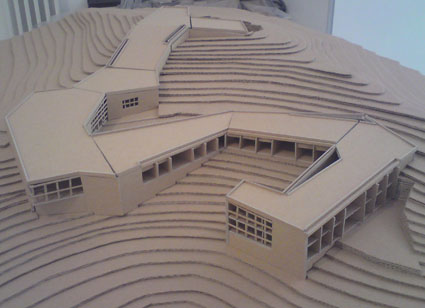

During summer vacations on Paros, which is a touristic island, our visit at a quite attractive though non-developing place Molos and our contact with the residents of nearby villages motivated us to study methodically this area for our diploma project.
The occurrence of argil at Molos and the fact that this substance has already been used, in a non-organized seabeach, by both villagers and visitors due to its curative properties, make useful the creation of a building with baths and accommodation and necessitate configuration of the seabeach so as to become approachable and easily used. Moreover, the existence of three villages next to Molos (Marmara, Marpissa, Prodromos) with natural richness and architectural beauty generates the desire to include them to our proposal, creating recreation grounds in master plan (Marmara - artistic studio, Marpissa - open-air market, Prodromos - garden organizing recitations of poems). In order to connect all parts of our studying area, we propose a new net of paths with widenings for station points.
Our planning proposal attempts to incorporate hypsometric variations through the interior of the complex and its essential rooms, and also through their synthesis intending to their normal operation. Our aim is making the building be subsumed under the topography and seem a normal continuity of the ground.
In the interior of the building there is reception – lobby, 21 spare rooms, bathing rooms (massage, hydro massage, pool, mud bath) and places of amusement (café - restaurant, music room, reading room).
The building is constructed by reinforced concrete and stone of Paros, while the interior walls are made from wood and floating screed. Beyond the use of stone, we also make the use of wood, shading mat and marble of Naxos.
Supervisors: Kotionis Zissis, Fyga Dimitra
Reference Number: 274


The creation of the 38.000 acres lake Karla is expected to change gradually the nature of the Thessaly plain. This project is characterized as a project of multiple feasibility, having the environment as its main consideration. It has also significant development, production and social implications. It has appeared a unique opportunity to partially restore the antecedent ecosystem and operations of the past. The creation of the lake aspires to be an important step for the management of the natural and anthropogenic environment of the region based on the principles and guidelines of sustainable development.
The degree thesis project is a suggestion of this great development task with facilities which have been principally aimed at upgrading the region, raising the awareness of citizens for the protection of the environment and also creating a pole of attraction both by visitors and environmental scholars.
The intervention region is located at the north east area of the lake, at a point which the water meets the ground without interrupted by the levees. This area is going to be implanted so that to have as a result a new and more rich environment and also to attract the fauna which has been quite reduced the recent years.
The first design approaches based on the preexistent linings and axes of the irrigation channels, the agricultural parcels, the grids generated by the existence of orchards and the new projects and dams that have been constructed for the creation of the lake. The final outcome was a creation of three axes which gained a notional nature as each of them has different uses, recreation, information and research. The connection of these axes has been made through routes which have the form of piers. One of the main objectives of this project was the intervention to be reversible and that is why materials such as wood, reeds and stone have been used, materials that grow old naturally and have little impact on the environment.
The proposed facilities are as follows: information centre, research centre, boat station, hostels and coffee house. The building complex includes also parking areas, rest areas, plant and fish farms and watching towers.
Supervisor: Triantafillidis Giorgos
Reference Number: 264
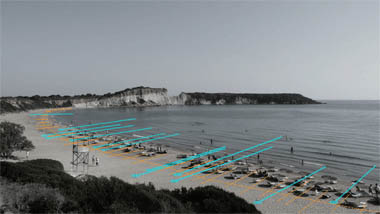





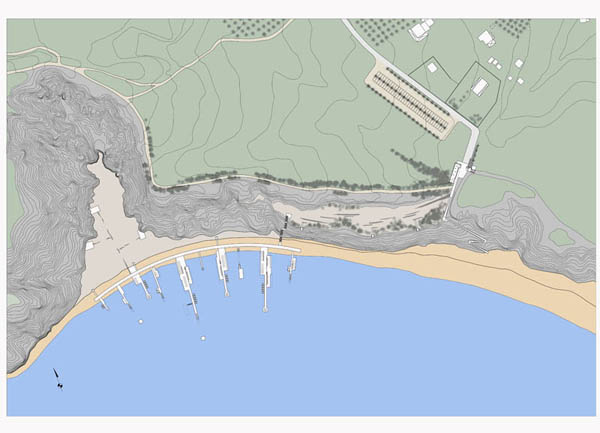



This paper begins with a study of the protected beach of Gerakas in Zakynthos as a nesting site of the sea turtles Caretta - Caretta, and the actions of the National Marine Park of Zakynthos. Originally thera is a study of the limitations and rules that are set by N.M.P.Z. and of the characteristics of the environment at Gerakas. Human activity is recorded and divided into that of managers and scientists of the Park, and that of the visitors - bathers, while these movements are contrasted with movements of the sea turtles. While the landscape and the naturalness of the area is being analyzed on a human scale and the physical experience of visitors. The facility is designed to eventually guide the bathers in the landscape, informing him of the specialty of Gerakas, leaving him to read the data space and the naturalness of the environment during his descent to the beach, offering or exposing different sightings of the entire landscape or limiting the textures and details of the space around it. It also acts as a separating factor between turtles and humans, leading swimmers in the coastal area where usually are not observed nests of the Caretta-Caretta, while transferring the bathing activity from the beach entirely in water - above or below. The visitor is guided on wooden platforms above the water line, by traces on the path and gives individuals the freedom to choose where they will remain in the region and the relationship they wish to have with the water. Features incorporated in the facility serve the basic needs of visitors in order not to alter the nature of the protected zone. The facility clicked on the landscape and uses penetration piles as support of individual buildings to achieve minimum intervention in the landscape, while the wood is preferred as a primary material of intervention as a natural material and one with the best relationship it might have with the landscape.
Supervisor: Gavrilou Evelyn
Reference Number: 313


This is a study of expansion and remodeling of the polytechnic colleges of the university of Thessaly. planning area is defined as the current plot university complex, the southwest part of the Palaia region, and the triangle between the roads Sekeri, Alamanas and Athinon avenue.
Observation data were collected for steering the course of design and synthesis. The population group of students active in the urban fabric, the topography and geography of the city, the boundaries of the area and the relationship with the immediate surrounding environment, were significant comments.
The joint activities of the crowded, uniform, group of students, their concentrated houses, combined with the compact nature of the center of the city of Volos, shape a free, unplanned, spontaneously formed campus in the urban fabric which is simultaneously a main power supply system for the city economic, cultural, recreational and social area.
The aim is to design a core in the university area, capable of dealing with the existing one in the city and the creation of a link between them. New additions to the university complex is the building of electrical engineering, a library, sports facilities, student dinning club, workplaces of architecture engineering, public auditorium, offices of Dean, and student residences. As an axis connecting the urban fabric and the university complex, but also as the centerpiece for the design, launched a bicycle path that runs through the city's coastline, and also supplies and crosses the campus.
Supervisors: Gavrilou Evelyn, Daskalakis Konstantios
Reference Number: 284


The main purpose of this research is to define, on a different basis, the connection and the reaction between the City and the University. The basic idea is set on the construction of a building area which will provide the dynamics to create a contact between the City inhabitants and the University community.
On Athens avenue the empty lot OT.1204 is picked to host new educational uses for the Polytechnic School of UTH, combining cultural, commercial and social activities open to the public. The main target is to make this area work as a joint of educational and social growth. The idea of the whole construction is to be incorporated into the neighborhood without disharmonizing the balance of the community. On the other hand it must provide a shield to the educational processes, without cutting out the public.
The research on this lot is based on the functional needs and the buildings plan of the University, the location and the orientation of the lot, taking in consideration the city's needs and the population's habits. All the above parameters should be harmonized to the Architecture Basis we wish to input.
Picking the location, the lot's position on the city map, the orientation plus the insolation and ventilation projects as well with the environmental friendly materials for a Green project are under the Certification of LEED 2009.
Supervisor: Kotionis Zissis
Reference Number: 298

